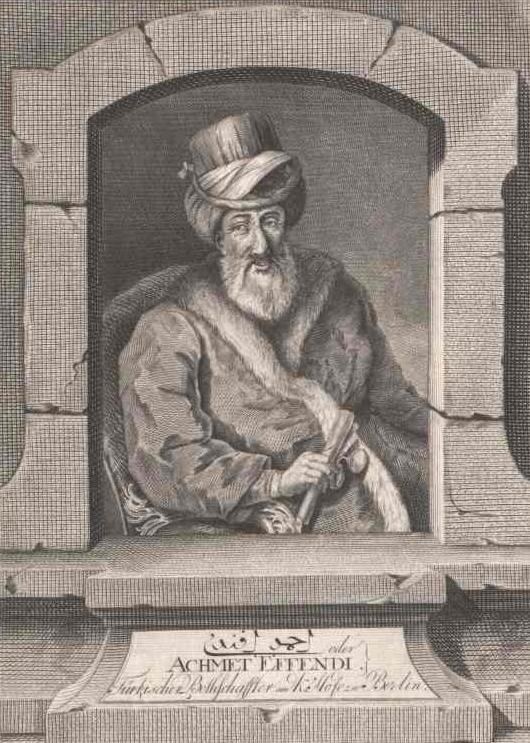Nationality Greek Role Author | Name Ahmed Efendi Died 1783, Istanbul, Turkey | |
 | ||
Books Summary of Admonitions: A Chronicle of the 1768-1774 Russian-Ottoman War | ||
Achmet Resmi Efendi (English, "Ahmed Efendi of Resmo"), also called Ahmed bin Ibrahim Giridi ("Ahmed the son of Ibrahim the Cretan"), was a Greek-Ottoman statesman, diplomat and author of the late 18th century. In international relations terms, his most important - and unfortunate - task was to act as the chief of the Ottoman delegation during the negotiations and the signature of the Treaty of Kucuk Kaynarca. In the literary domain, he is remembered for various works among which his sefaretname recounting his embassies in Berlin and Vienna occupy a prominent place. He was Turkey's first ever ambassador in Berlin.
Contents
Early life
Ahmed Resmi was born into a family of Greek descent in the Cretan town of Rethymno, which was known as Resmo in the Ottoman Empire in the year 1700. According to Muhammed Muradi, the source for the little that is known concerning his early life, Ahmed Resmi arrived in Istanbul towards his forties, in 1734. Most sources credit him with expertise in the calligraphic and epistolary arts. Rising through the Ottoman bureaucracy, he allied himself with a circle of reformers, who transformed diplomatic relations of the Ottomans with Europe in the 18th century and established some of the first privately endowed public libraries of Istanbul.
When his father-in-law and first patron Tavukcubasi Mustafa, a diplomat and one of the prominent figures in grand vizier Koca Mehmed Ragip Pasha's entourage, died in 1749, Ahmed Resmi began writing his first work, the bibliographical compilation of Ottoman chief scribes "Sefinet ur-ruesa". It was in this period that he wrote "Istinas fi ahval el-efras", to demonstrate his scribal and literary skills, celebrating the spring ritual of releasing the royal horses for grazing and which served as an encomium to the Sultan Mahmud I. These works also served as a means of introduction to potential patrons, such as grand vizier Kose Bahir Mustafa Pasha.
Ahmed Resmi was appointed in late 1757 to an embassy to Vienna to announce the accession of Mustafa III to the throne. In 1749, he also composed "Hamilet el-kubera", a biographical list of the chief black eunuchs (kizlar agalari) of the Palace.
The embassy to Vienna was followed by a similar appointment, the first ever Turkish embassy to the court of Frederick the Great in Berlin in 1763/1764. After both embassies, Ahmed Resmi submitted detailed reports on the geography of his passage and the politics of the courts he encountered. In the case of the Berlin embassy, he left behind not just an account of diplomatic niceties but also a portrayal of Frederick and the description of the Seven Years' War. His tentative observations inaugurated a new emphasis for the Ottoman Empire on the need to study European politics.
Upon his return from Berlin, he was appointed chief correspondence officer (mektupcu) to the grand vizier. In 1765, he became chief sergeant-at-arms (cavusbasi) and began his long connection with Muhsinzade Mehmed Pasha, who was twice appointed grand vizier. Among his other appointments to the highest offices was his brief posting as second-in-command (sadaret kethudasi) to grand vizier Moldovanli Ali Pasha in 1769 while the grand vizier was on the Bulgarian battlefront. He served in this capacity again with Muhsinzade Mehmed Pasha from 1771 until the grand vizier’s death at the end of the Russo-Turkish War, 1768-1774. Ahmed Resmi was present at many of the war councils on the battlefield and was noted for his largesse toward wounded soldiers. His quarrels with and observations on the head of the Ottoman delegation during the ten-month truce between the two episodes of the war, Cenebaz Osman Efendi or Yenisehirli Osman Efendi, by the name either of a town near Bursa or now in Greece, was recorded by him in one of most vivid accounts of the war.
Even though the above-mentioned three posts were considered stepping-stones to the office of grand vizier, he never achieved that status. It is likely that Ahmed Resmi’s regular and scathing criticism of the state of Ottoman military organization played a major role in this turn of events.
Ahmed Resmi acted as first plenipotentiary (murahhas-i evvel) to the Kucuk Kaynarca peace negotiations in 1774 and became one of the signatories of the resulting treaty. He understandably disappeared from the appointment rolls for some time after 1775. Ahmed Resmi resurfaced one last time as chief of the palace cavalry bureau (suvari mukabelecisi) under grand vizier Halil Hamid Pasha, probably in recognition of his continuous service behind the scenes in difficult negotiations with Russia over the future of the Crimea and the Tatars. Ahmed Resmi died in August 1783, shortly before the Aynalikavak Convention ceding the Crimea to Catherine II was signed in early 1784. One son is said to have preceded Ahmed Resmi to the grave; no other information has been discovered to date concerning his family life.
Literary works
His two works on Vienna and Berlin embassies have been translated into German by Joseph von Hammer in 1809.
